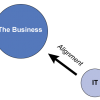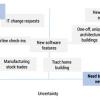Business Transformation Requires Transformational Leaders
Leadership and teaming skills are front and center in times of rapid change. Meet today’s constant disruption head on with expert guidance in leadership, business strategy, transformation, and innovation. Whether the disruption du jour is a digitally-driven upending of traditional business models, the pandemic-driven end to business as usual, or the change-driven challenge of staffing that meets your transformation plans—you’ll be prepared with cutting edge techniques and expert knowledge that enable strategic leadership.
Recently Published
Due to its ability to view an enterprise through a common lens, business architecture offers unique insights into the impact and viability of various business strategies and requirements.
This Executive Update, Part I in a series of three, explores (and debunks) the traditional notions of business/IT alignment and offers a more pragmatic approach to keeping IT in sync with business objectives through business capabilities. It also considers the critical role that enterprise architecture (EA) can play in this process.
Understanding how to become Agile starts with understanding the kind of work your organization performs.
For many practices, it’s a change in lexicon or technology that make them new “flavors,” but the underlying principles remain the same. We need to embrace our teams. We need to identify what we expect of them, and give them the tools and capacity to accomplish their goals. Read between the lines of virtually any new approach, and there should be signs of an homage to what’s been done in the past (and done well).
Blockchains and the IoT: Realizing the Economic Potential
This Executive Update focuses on how the Internet of Things and blockchains are at the front of a broad shift toward decentralization that involves moving computing power and information ownership to the edge, while bringing more control to consumers and end devices. As such, the onus for leading this shift lies on the user communities and influential consumers (e.g., large businesses, federal governments, city councils) rather than the vendors themselves. Realizing this technology shift is going to be as challenging as the opportunity it presents. The economic potential can be tapped gainfully only if the barriers are addressed holistically by all relevant stakeholders. The tipping point for mass adoption will be reached when the availability of common standards and ubiquitous communication infrastructure enables a compelling value proposition for consumers and viable business models for technology providers.
Rethinking Agile Transformation
Agile has been “officially” around for more than 15 years; at its start, the purpose was to overhaul software delivery practices. Today, Agile is being executed in a completely different world — a world filled with disruption, where more organizations are greatly affected by external factors that they can’t control. As we explore in this Executive Update, rethinking Agile transformation starts with building a community that mimics how social systems work. You will need experience (and expertise) with Agile, but you don’t necessarily need a VP of Agile for that. You need to create an army of Agile champions who will spread the change virally.
Maturing a Business Architecture Practice: The Promise and the Path
Business architecture is proving itself to be a critical discipline for bridging the gap between strategy and execution. Whether encouraged by the increasing speed that the discipline is growing globally or their own firsthand experiences with its value, organizations are continuing to invest in establishing internal business architecture practices. However, many do not realize the full potential of what business architecture can achieve for an organization when fully matured. In fact, many do not have a clear vision of what “fully mature” even means. This Executive Update will paint a picture of what a mature business architecture practice looks like, summarize the achieved value as a result, and provide a practical perspective on how to get there.
Introducing Agile causes pain to your organization. This is not because Agile doesn’t work — it works for hundreds of organizations, some of them probably quite similar to yours. This is because Agile shows you the problems and deficiencies in your organization as brutally as the mirror you look into in the morning after a late night out. It is not the mirror that makes you look bad! The short iterations of XP and Scrum and the focus on lead time in Kanban work better the more mature the engineering and management skills in your organization are.

















